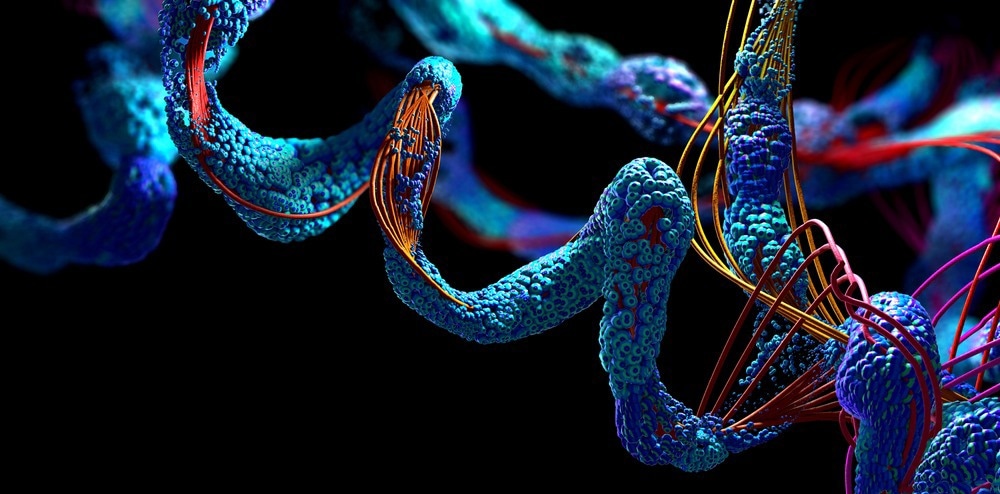Antimicrobial peptides (AMPs) have a broad spectrum of antimicrobial activity and lyse microbial cells by interaction with biomembranes, offering great potential in designing new therapeutics. The antimicrobial resistance (AMR) caused due to overuse of antibiotics can be circumvented by using AMPs as alternatives to antibiotics.

Study: Design of chitosan nanocrystals decorated with amino acids and peptides. Image Credit: Christoph Burgstedt/Shutterstock.com
The rod-shaped chitosan nanocrystals are polysaccharide-based nanomaterials obtained by deacetylation of marine biomass waste. The primary amino group on the surface of chitosan nanocrystals helps in surface functionalization, tuning their surface properties. An article published in the journal Carbohydrate Polymers presented a new methodology to functionalize the chitosan nanocrystals with peptides and amino acids via solid phase peptide synthesis.
The resulting rod-shaped functionalized chitosan nanocrystals were characterized using dynamic light scattering (DLS), nuclear magnetic resonance (NMR), transmission electron microscopy (TEM) imaging, and zeta potential measurements. This synthetic strategy can be designed to generate target-specific nanomaterials based on chitosan nanocrystals through the attached peptides on the surface of the nanomaterials.
Chitosan Nanoparticles and Solid-Phase Peptide Synthesis
Chitosan, also known as deacetylated chitin, is a natural polycationic linear polysaccharide derived from the partial deacetylation of chitin. Chitosan is composed of β-(1-4)-linked d-glucosamine and N-acetyl-d-glucosamine that are randomly distributed within the polymer.
The cationic nature of chitosan is rather unique, as most polysaccharides are usually either neutral or negatively charged in an acidic environment. Besides, chitosan is reported to have other biological properties, such as antitumor, antimicrobial, and antioxidant activities.
Chitosan nanoparticles combine the natural properties of polymers with tunable sizes and the possibility of surface modification according to requirements. Thus, chitosan nanoparticles are a promising and versatile strategy to overcome most active ingredients' bioavailability and stability issues.
Chitosan nanoparticles are highly important in nanomedicine, biomedical engineering, and the discovery and development of new drugs. They are used to create new release systems with improved bioavailability, increased specificity and sensitivity, and reduced pharmacological toxicity of drugs.
Chitosan nanocrystals are rod-shaped nanomaterials of 100-200 nanometers in length and 5-20 nanometers in width, formed by the deacetylation of chitin nanocrystals. These nanocrystals are nontoxic materials with a large surface area, high mechanical strength, and tunable colloidal and self-assembly behavior in aqueous media, making them suitable for several downstream applications in nanomedicine drug delivery, food packaging, and the papermaking industry.
Because of their cationic and nanometre dimensions, several reports have mentioned chitosan nanoparticles in drug delivery systems. The primary amino groups present on the surface of the chitosan nanomaterial facilitated surface functionalization to impart tunable properties to the chitosan derivatives.
Solid-phase peptide synthesis is a popular method for synthesizing peptides of various lengths. This involves the successive addition of protected amino acid derivatives to a growing peptide chain immobilized on a solid phase, including deprotection and washing steps to remove unreacted groups and side products, resulting in the formation of a predetermined peptide moiety.
Chitosan Nanocrystals Decorated with Amino Acids and Peptides
The present study developed a new strategy to functionalize chitosan nanocrystals with peptides and amino acids of different lengths using a fundamental solid-phase peptide synthesis method. In addition to the tunable properties of chitosan nanocrystals owing to the presence of amino functional groups on the nanomaterial surface, the chitosan nanocrystals also have an intrinsic morphology and nanometre size, which facilitates their use as a scaffold.
Here, solid-phase peptide synthesis involves assembling the peptide chain through a series of coupling and decoupling reactions of amino acids on an insoluble resin, followed by cleavage of the desired peptide chain from the resin.
Furthermore, the insolubility of chitosan nanocrystals under the reaction conditions of peptide coupling enabled the treatment of nanomaterials and resins similarly. Moreover, the reactivity of the amino groups on the nanomaterials was utilized to anchor amino acid residues.
The formation of the functionalized rod-shaped nanomaterials was characterized using NMR, DLS, microscopy, and zeta potential measurements. While NMR results confirmed the esterification of chitosan during the reaction with amino acids, TEM images showed well-dispersed rod-like particles, indicating that the surface chemical modification did not affect the structure and morphology of the nanocrystals. Thus, the present synthetic strategy could have promising applications in designing chitosan nanocrystals with target specificity.
Conclusion
Overall, a new methodology was developed to modify the surface of chitosan nanocrystals by utilizing peptides and amino acids of different lengths via solid-phase peptide synthesis. This strategy used the primary amine functional groups present on the surface of chitosan nanocrystals and carboxyl groups of amino acid residues in organic solvents to produce peptide-modified chitosan nanocrystals.
The relative insolubility of chitosan nanocrystals in organic solvents makes the synthesis of chitosan nanocrystals convenient through a series of stepwise deprotection and coupling steps. The rod-shaped morphology, nanometer size, and tunable properties of chitosan nanocrystals impart them with target specificity by attaching bioactive peptides to the surface of nanomaterials.
Reference
Hrapovic, S et al. (2022). Design of chitosan nanocrystals decorated with amino acids and Peptides. Carbohydrate Polymers. https://doi.org/10.1016/j.carbpol.2022.120108
Disclaimer: The views expressed here are those of the author expressed in their private capacity and do not necessarily represent the views of AZoM.com Limited T/A AZoNetwork the owner and operator of this website. This disclaimer forms part of the Terms and conditions of use of this website.